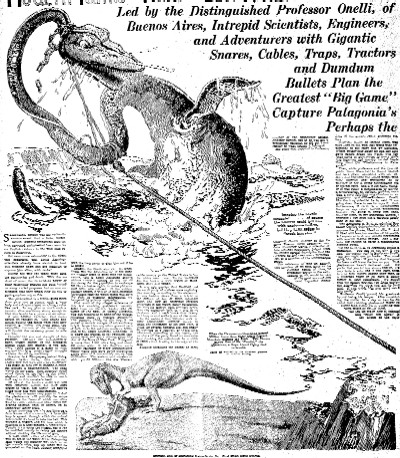
January 15, 2007
Click on image for a full size pdf version of the April 9, 1922, Lima, Ohio, graphic.
Today, the lake monster reported in Lago (English: Lake) Nahuel Huapi in the northern Patagonia region between the provinces of Río Negro and Neuquén, in Argentina, near the border with Chile, is called “Nahuelito.” The huge lake itself, which is about 1350 feet deep, covers over 300 square miles at the base of the Patagonian mountains, a perfect site for a watery cryptid, variously described as a giant serpent or a huge hump. Or a prehistoric dinosaur?
Forget about Africa’s Mokele-mbembe hunts in the early 20th century, for a moment. This year marks the 85th anniversary of another “dino expedition” that was conducted in South America. According to old news accounts, they appeared to be truly Art Deco adventures in search of “Lost World” monsters. During the 1920s, all the rage in the media came from the quest for the celebrated “Patagonian Plesiosaurus.”

The “Patagonian Plesiosaur” or “Plesiosaurus” first attracted press coverage in the beginning of the Roaring 1920s, though sightings go back well into the previous century. The director of the Buenos Aires Zoo Clementi Onelli had gathered accounts for years.
In 1897, a Chilean farmer in Patagonia reported hearing the sounds of a heavy creature dragging itself along the pebble beach of a nearby lake. Sometimes, at night, the witness could see a long-necked, swan-like form in the water of White Lake.
Next, a man named Vaag discovered animal remains and spoor along the banks of the Rio Tamanga. Onelli was convinced that the traces Vaag found were those of a plesiosaur. Onelli revealed a third sighting in 1913, when locals said a similar creature surfaced in a body of water in the Santa Cruz area.
The international search for the “Patagonian Plesiosaur” began in earnest in 1922, after Onelli was sent a fourth series of reports of large unknown tracks and matted weeds on shore, which Onelli placed in the context of the reports of the locals seeing a monster in the middle of Lago Nahuel Huapi. In 1922, a specific report was brought to Onelli’s attention by a prospector named Martin Sheffield who encountered one of the monsters in the hilly Chubut Province of Patagonia. Sheffield said he saw a creature with “a huge neck like a swan,” that moved like a crocodile.
Onelli mounted an expedition to find Sheffield’s “Pleisosaurus,” but the trek produced no results. Nevertheless, the media followed every move they could of the search and added new stories to the mix. For example, during the 1922 press attention, George Garrett came forth to tell the Toronto Globe on April 2, 1922, that he had seen a monster (Nahuelito) in Lago Naheul Huapi in 1910.
A subsequent expedition, led by zoo superintendent José Cihagi, produced nothing of consequence.
Regarding all the hunts, writing in the July 1922 issue of Scientific American, Leonard Matters remarked that the plesiosaur, “if it ever existed, appears to have fled to parts unknown.”
Reports of Nahuelito continue today, into the 21st century.
Sources: Thanks to Craig Heinselman for the old news clipping scans. Material on the expeditions from Cryptozoology A to Z (NY: Simon and Schuster, 1999), and The Field Guide to Lake Monsters, Sea Serpents, and Other Mystery Denizens of the Deep (NY: Tarcher/Penguin, 2003).
About Loren Coleman
Loren Coleman is one of the world’s leading cryptozoologists, some say “the” leading living cryptozoologist. Certainly, he is acknowledged as the current living American researcher and writer who has most popularized cryptozoology in the late 20th and early 21st centuries.
Starting his fieldwork and investigations in 1960, after traveling and trekking extensively in pursuit of cryptozoological mysteries, Coleman began writing to share his experiences in 1969. An honorary member of Ivan T. Sanderson’s Society for the Investigation of the Unexplained in the 1970s, Coleman has been bestowed with similar honorary memberships of the North Idaho College Cryptozoology Club in 1983, and in subsequent years, that of the British Columbia Scientific Cryptozoology Club, CryptoSafari International, and other international organizations. He was also a Life Member and Benefactor of the International Society of Cryptozoology (now-defunct).
Loren Coleman’s daily blog, as a member of the Cryptomundo Team, served as an ongoing avenue of communication for the ever-growing body of cryptozoo news from 2005 through 2013. He returned as an infrequent contributor beginning Halloween week of 2015.
Coleman is the founder in 2003, and current director of the International Cryptozoology Museum in Portland, Maine.
Filed under Breaking News, Cryptomundo Exclusive, Cryptotourism, CryptoZoo News, Cryptozoologists, Cryptozoology, Expedition Reports, Eyewitness Accounts, Lake Monsters, Living Dinosaurs, Media Appearances